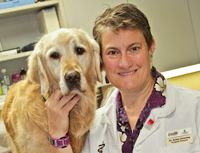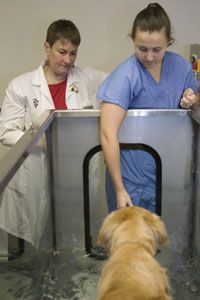Veterinary case study: Share your own pets' struggles
Sharing personal stories of pet illness in exam rooms, veterinary newsletters and emails can bridge the gap between a seemingly trouble-free veterinarian and scared clients.
Next >
I read the first emotional and educational email on a Monday morning before my coffee.
Dr. Robin Downing, owner of the Downing Center for Animal Pain Management, explained in a mass email to dozens of family, friends, and colleagues that she and her partner Sharon DeNayer's work and home companion, the Golden Retriever Farrah, had cancer.
Dr. Downing went on to tell her readers much more than I'd seen many other veterinarians explain about a personal pet's condition. She shared some of the clinical decisions behind her choices in treatment. She shared observations of Farrah's still buoyant spirit. And she promised—a promise she has kept—to keep us informed.
Whether it's a fought-and-conquered illness ("I beat it"), a developing condition ("Yeah, it’s tough"), or a lost cause ("I take it day by day"), seldom do veterinarians or physicians share when they go through the same ups and downs as their clients.
Dr. Downing has also agreed to share some of these emails with the wider dvm360 audience. Honest and transparent communication like this can help show clients that they're not alone, that you do understand, that you’ve been there.
"Sometimes clients think veterinarians get different outcomes because we're veterinarians," Dr. Downing told me. "We don't. I just want people [with sick pets] to understand they're not alone."
Read the following emails from Dr. Downing and consider whether you might build a better patient-client-doctor bond by sharing the decisions you made—and make—when your own pets are the patients. Remember, in this case, Dr. Downing emails are for a medically knowledgeable audience (like you), so there's some medical nomenclature.

Saturday, April 7
Greetings.
Farrah, as you know, is our lovely and brilliant Golden Retriever. She was named "Farrah 'Leaky' Faucet" because she was born with ectopic ureters. Once she was 8 months old, our dear friend Dr. Ron Bright rebuilt her plumbing and we dropped her middle name.
Farrah has been my demonstration dog during countless pain management training sessions, helping graduate veterinarians, graduate veterinary technicians, veterinary students, and veterinary technician students hone their palpation skills. Thirty people palpating her—a dog with no pain issues—meant no ethical dilemmas for me, and it meant lots of massage for Farrah.
She will be 10 on May 22, and in defiance of chronology, she and I (with two of our other dogs) walk between 25 and 30 miles each week. Farrah's resting heart rate is 55 beats per minute, and her systolic blood pressure at rest is 96 mmHG (normal is 110 to 130). Her personal record for swimming is 3.5 hours in the water with only occasional bottom-touches, and her body condition is 2.75 on a 5 scale. In spite of all that she couldn’t outrun serious illness.
On February 22 at 2:30 a.m., Farrah suffered a gran mal seizure while I was teaching at a conference. That freaked out Sharon and the other pets in the household, as you can imagine. A complete metabolic workup, including abdominal ultrasound and chest films, revealed no explanation. Her second seizure happened three weeks later at 4:30 a.m. on March 14. That’s the day she started phenobarbital to suppress any additional seizures until we could schedule the final diagnostic step: an MRI.
Thursday, April 5, our beloved Farrah was diagnosed with a brain tumor.Her tumor is located between her eyes and behind the sinuses and appears to be (according to the radiation oncologist and the radiologist) most consistent with a meningioma. It is about the size of a walnut. It is not operable. Fortunately, meningiomas are quite radiosensitive, and that means we have a treatment option.
I am so grateful to live where I do. Colorado State University is one of only a few facilities to offer stereotactic radiation therapy, which is a high-dose, precisely focused delivery of radiation (in this case, 8Gy delivered daily for 3 days for a total of 24Gy) designed to interrupt the DNA replication of the tumor and thus arrest its development. The alternative is the more fractionated radiation therapy, which involves treatment five days a week for four weeks to achieve the desired total Gy dose.
The team at the Animal Cancer Center at CSU are putting their heads together to compile Farrah’s plan. We will decide Monday, following their kibitzing, which protocol we will follow.The tumor is very close to where the optic nerves cross to send fibers to the opposite sides of the brain. Damage there from radiation could result in blindness, so we will be looking carefully at risk potentials and risk-to-benefit ratios as we proceed. Higher doses may make the risk to vision too high, but the longer protocol means many more back-to-back anesthesias. Median survival with radiation for this tumor type is 20 months, and should it recur, she would be a candidate for a second treatment with an expectation for about half the previous disease-free interval. Potentially, she may still live to a normal life expectancy.
Sharon and I are devastated at this turn of events, but we remain cautiously optimistic. Farrah is, hands down, the most incredible dog who has yet graced our family. Farrah looks upon this as just another new adventure, based on her behavior so far when we deliver her to her care-givers at CSU.
We appreciate any prayer/spiritual/intention energy you are willing to send in Farrah’s direction.
I promise to provide updates as we move along this path.
Thanks for listening.

Monday, May 14
Greetings.
Thank you again so much for the good thoughts and warm wishes sent our way during Farrah’s ongoing journey with her brain tumor.
So, it has been exactly five weeks since Farrah had her first of three doses of stereotactic radiation therapy at CSU. Just shy of the four-week mark—May 5—she exhibited a significant change in her mentation. She urinated on herself in her sleep Friday night, she was dull Saturday morning, she couldn't go on her morning walk (we managed one block, but she was dragging so badly we had to turn around right there), and she was truly not herself.We had been prepared to expect some evidence of brain inflammation/swelling as well as some potential de-myelination of nerves, both of which should respond to an increase in her corticosteroid dose. We did precisely that, and over the next week, her mental symptoms resolved.
By this Saturday, she was back in the groove of morning walks.One thing I neglected to anticipate was the rapid weight loss and muscle catabolism that would happen during and after her series of anesthetic events as well as the immunosuppression associated both with general anesthesia and radiation therapy. So, Farrah had a very rapid weight and body condition loss, followed by a urinary tract infection. I must admit I am much better with these kinds of details with other people’s animals! She is finishing up her antibiotics, so the UTI is resolved.
She thinks she has hit the lotto in the food department ... she is now consuming nearly 2,000 calories per day! I don’t know many humans who can get away with that kind of calorie load!
< Back | Back to Page 1 >

Sunday, July 1
Greetings.
Thank you so much for the outpouring of love and support as we make this cancer journey with our special girl, Farrah Faucet.
It was two weeks ago today that we uncovered Farrah's second cancer, which had spread throughout her abdomen (carcinomatosis). Thanks to Farrah's oncology team at CSU, we have a plan, and we began working that plan this past Monday.
Farrah started an oral chemotherapy developed to treat a type of cancer called "mast cell tumor." Since the drug's release, veterinary oncologists have been expanding its use to other challenging cancers. There is not yet much data about the drug for use on carcinomatosis, but the preliminary information is promising.
Monday morning we withdrew just over half a liter of fluid from Farrah's abdomen as we began her treatment plan. We will monitor the fluid in her abdomen (caused by the cancer) to measure the success or failure of the new drug. We've been told to plan for about a month of therapy before we will know if Farrah is a "responder." If she responds well, the fluid in her abdomen will decrease. If she does not respond, then the fluid will continue to accumulate unabated. We remain cautiously optimistic.
The good news is that Farrah remains blissfully unaware that she is dealing with a life-limiting disease. We are a bit concerned because her appetite is off (a golden retriever with a decreased appetite? Unbelievable!). That said, rotating food has solved the problem for the moment.
She will have some laboratory updates weekly, and we will monitor and remove abdominal fluid as needed during this first month of treatment.
Please keep Miss Farrah in your thoughts—she needs all the help she can get!
Note: At press time, Dr. Downing continues to provide us with updates every week or two, and Farrah is still going strong, living with cancer, and raising money for the American Cancer Society. You can read Farrah’s blog about the event here.
2 Commerce Drive
Cranbury, NJ 08512
All rights reserved.